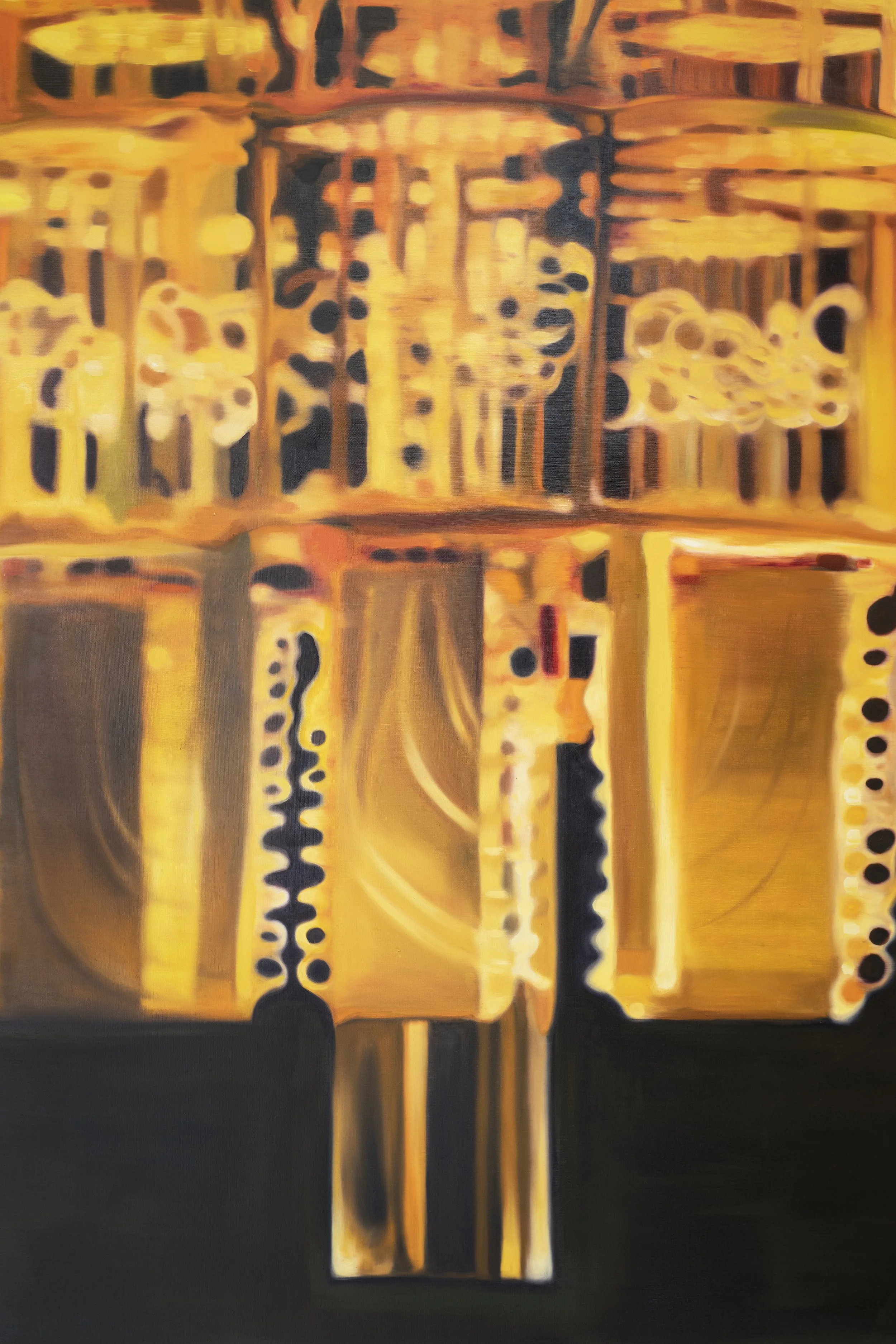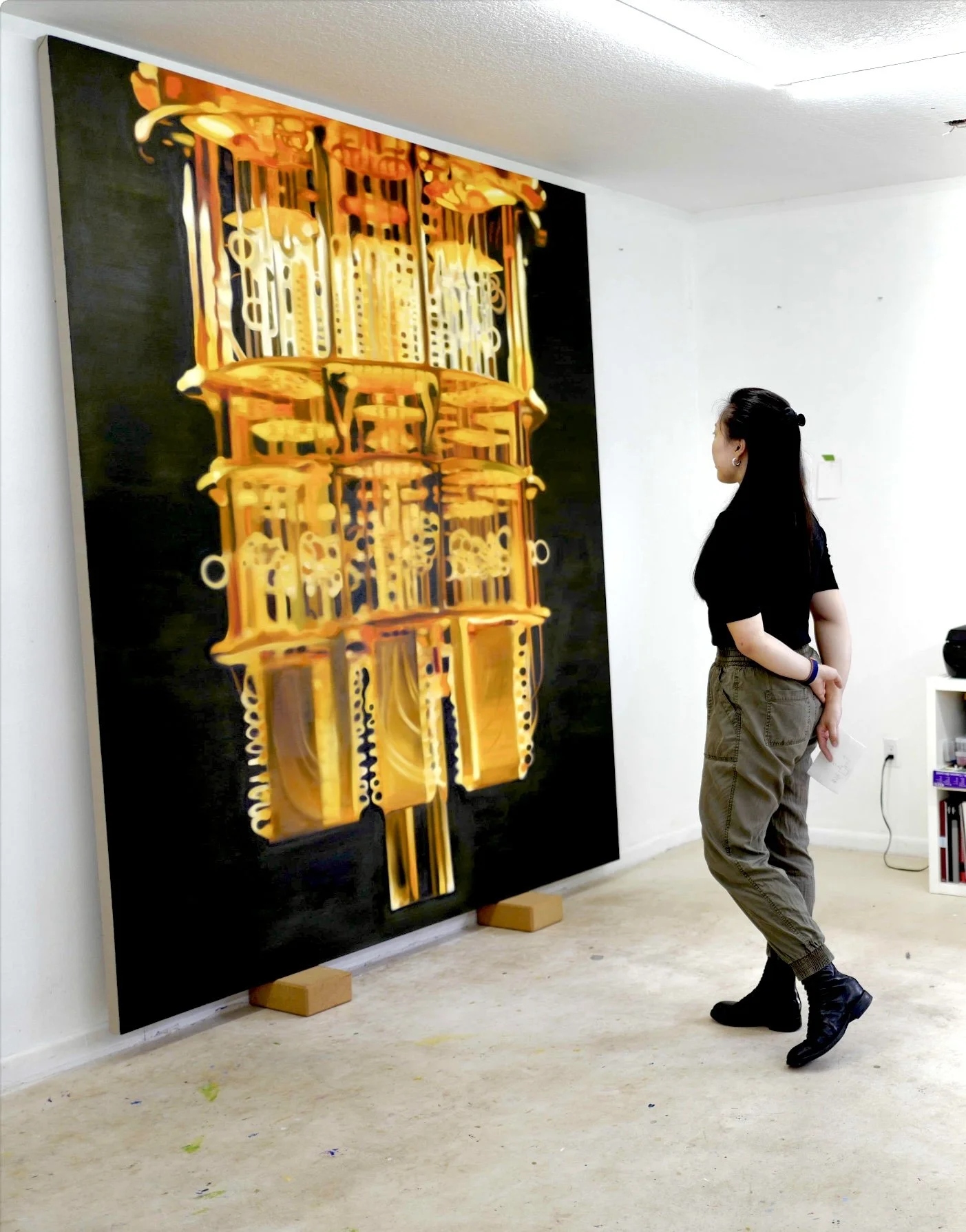Quantum Gaze, 2023
Quantum Gaze, 2023
Oil on linen
244 x 193 cm (96 x 76 in)
The rise of quantum computing signals a paradigm shift in technology, transcending mere utility to embody an intricate structural elegance—one that mirrors the fundamental principles of the quantum realm. Governed by superposition and entanglement, this complex apparatus represents the pinnacle of computational advancement, capable of solving problems once thought insurmountable. From molecular simulations to large-scale optimization, quantum computing redefines the limits of human ingenuity. In Quantum Gaze (2023), the boundaries between the tangible and the abstract dissolve, reflecting the paradoxical nature of quantum mechanics, where particles exist in multiple states simultaneously. The painting transforms the rigid structure of a quantum processor into an ethereal vision, echoing the uncertainty and fluidity inherent in both quantum states and our evolving relationship with artificial intelligence. As we stand on the brink of an era shaped by quantum computation, this work invites contemplation—of the unknown, of possibility, of uncertainty and of the intricate fusion between human cognition and machine intelligence.
Paris+ par Art Basel, October 18 – 22, 2023, Grand Palais Éphémère, Paris
Q: What sparked your interest in quantum computers?
Tan Mu: Quantum Gaze is the culmination of my ongoing exploration of quantum computers. My earliest painting of a quantum computer, Quantum Computer, was created in 2020 and depicted a quantum computer with its external casing, while this new work focuses on its internal structure. I have been deeply fascinated by quantum computers, especially since 2019, when they were regarded as one of the most advanced technological achievements. The launch of IBM Q System One marked a significant milestone in the commercialization of quantum computing, representing the cutting edge of human ingenuity at the time and pushing the boundaries of technology. It embodied the breakthroughs of human intellect and technological achievement. It was this intuitive sense of transformative breakthroughs that inspired me to create this painting, capturing this historic moment.
When I completed that painting of the quantum computer, I felt strongly that it resembled a "portrait." Therefore, I approached this exploration from the perspective of a "portrait," which continued my earlier investigations into cells, the brain, and the idea of "humans as machines"—juxtaposing physical devices with the body, and technology-driven thought with human memory and consciousness. If we imagine an individual's mind housed within a physical shell, it essentially becomes a transformation of hardware and software, much like this quantum computer. Thus, these two paintings are not merely depictions of computing machines but also philosophical reflections on how humans understand themselves, reality, and the exploration of the unknown.
Q: How do technological breakthroughs in quantum computing change our understanding of human cognition and the future, and how does your artistic exploration relate to these technologies?
Tan Mu: The technological breakthroughs in quantum computing are profoundly reshaping our understanding of human cognition and the future. Classical computers rely on binary systems (0 and 1) for computation, while quantum computers utilize qubits, which can exist in a superposition of both 0 and 1 simultaneously. Through quantum entanglement, multiple qubits can influence each other, vastly enhancing computational power. This technology has accelerated advancements in fields such as finance, chemistry, pharmaceuticals, and logistics, and may even help us unravel the essence of the universe. The breakthroughs in quantum computing are not merely technological progress—they represent an expansion of the boundaries of human cognition. We are beginning to tackle problems once deemed unsolvable, such as molecular simulation and AI optimization.
In my work Quantum Gaze, I sought to capture this expansion of cognition through visual language. The fundamental nature of quantum computing is probabilistic and uncertain, and this uncertainty may signify an explosion of creativity. Through Quantum Gaze, I hope viewers, while gazing at technology, also gaze at themselves. It raises many questions: How do we understand the world? How do we face the future? What is the role of humanity in an era where artificial intelligence and quantum computing converge? I cast these questions to the audience, inviting them to find their own answers within the elusive interplay of light and shadow. For me, the relationship between art and technology has never been oppositional but rather mutually inspiring. The complexity and uncertainty of quantum computing have ignited my creative inspiration, and my artistic exploration seeks to transform these abstract concepts into a tangible visual experience, allowing viewers to contemplate these profound philosophical questions more intuitively.
Q: In Quantum Gaze, how did you translate the complexity of quantum computing into a visual language?
Tan Mu: In Quantum Gaze, I attempt to express the uncertainty and multiplicity of possibilities in quantum computing through the interplay of light and shadow and the blurring of boundaries. The core principles of quantum computing—superposition and entanglement—evoke in me a sense of fluidity and the unknown, transcending traditional mechanical structures. To capture this essence, I chose a warm palette of golden and orange hues, focusing on the layered superconducting circuits, cooling systems, and intricate connections within a quantum computer, transforming them into a soft, dreamlike visual form. These structures appear to float in the darkness, resembling both guiding beacons and gateways to the future—metaphors for the boundless possibilities and uncertainties of technological advancement.
I deliberately create ambiguous boundaries and shifting light effects to offer viewers different perceptual experiences depending on their perspective and context. This design is inspired by the observer effect in quantum mechanics—just as quantum states collapse upon observation, I hope viewers, as they gaze upon the work, can experience a dynamic, multidimensional visual encounter. For me, Quantum Gaze is more than a depiction of a physical object; it is a poetic vision and a philosophical reflection. I seek to translate the complexity of quantum computing into an emotionally resonant visual language, inviting the audience to contemplate the relationship between technology and human perception, as well as how we confront the uncertainties of the future. Through this approach, I hope art can serve as a bridge between science and philosophy, inspiring exploration and imagination in the face of the unknown.
Q: What is the biggest challenge in translating the complexity of quantum computing into a visual language?
Tan Mu: My usual approach to creating painting is to mentally rehearse the process first—only when I know how to handle it do I start painting. When I worked on this piece, I went through three years of repeated contemplation and experimentation. From the initial concept to the final presentation, the painting underwent continuous adjustments, including changes in size as well as multiple revisions of the drafts. In the end, I had already envisioned all the details in my mind, to the point where I could "rehearse" the entire painting process mentally. This ensured that every layer and color treatment was precisely planned before execution. As a result, the painting fully captures the intricate beauty of a quantum computer’s internal structure. Throughout the creative process, having complete control over the work was crucial. Only with this rational pre-exploration and planning—deciding how to express every component—could it harmoniously integrate with the immersive and emotional engagement of painting.







